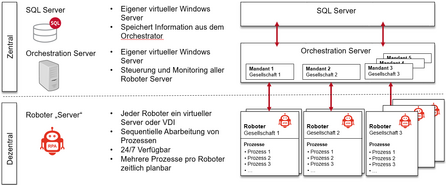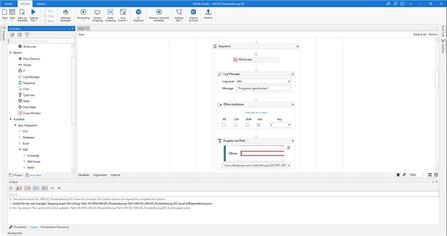
What is the article about?
For more than two years now, we in the Otto Group have been working on the topic of Robotic Process Automation (RPA), i.e. the automation of manual activities using RPA software. I deliberately write activities because in most cases it concerns individual activities rather than complete processes or process chains.
Thus, as Group IT, we are contact persons and experts in the implementation of RPA for the Otto Group companies. Within this collaboration, we jointly develop applications to automate processes and thus simplify them. For OTTO's category management, for example, we have automated the analysis of inventories and developed forecasting tools. In addition, we are currently working on applications for IT purchasing, HR and central controlling.
Based on these examples, you can see that it doesn't matter in which areas of a company (Finance, HR, IT, Article Management, Marketing, etc.) these activities or processes are located. RPA is a technology that can be used successfully in any of these areas. RPA helps employees to free themselves from time-consuming, manual activities.
In this article, I would like to introduce you to the WHAT, WHO and HOW of RPA in the Otto Group and give you an impression of where we are and where we want to go.
What is Robotic Process Automation?
When we talk about RPA, we are talking in simplified terms about software robots. This means applications that mimic human interaction with user interfaces of software systems. Here, the software robot works on the user interface in a similar way as a human would and additionally uses activities that are executed in the background (short keys, unique field descriptions, etc.).
There are two possible types of application. We distinguish between Attended and Unattended robots:

Attended robots are started by humans on a situational basis. They are currently mostly used for work that either only needs to be performed once or occurs irregularly from time to time. Examples are data migrations, mass data maintenance or test automations on front ends.
The greatest potential lies in attended robots: namely, if in the future each employee has his or her own small robot on the computer, which can easily be adapted to their own activities. More on this later.
Currently, most of the implemented robots are so-called unattended robots. That means bots that do not have to be started manually by humans every time, but can be scheduled via a scheduler and then started automatically. This is where a major advantage of RPA robots comes into play: the robot can work 24 hours a day. Whether at 1:00 in the morning, during the lunch break or late in the evening - the electronic colleague does not care about the working hours.
The field of application here is universal. Whether financial or controlling processes, in the HR area, in Categories, in IT or in other company areas: Wherever manual tasks are performed on a regular, recurring and rule-based basis, they should be carried out by a robot.
WHAT is already happening with RPA in the Otto Group or WHO is already automating with RPA?
Although there is no central RPA program in the Otto Group, we try to leverage as many synergies as possible in an RPA Otto Group Community. There are a number of companies that have already taken up the topic and are in part successfully automating processes or activities. There are regular exchange meetings to share knowledge about automated processes or the technology used and to discuss the latest functions and trends.
In this way, more than 100 activities or even complete processes have already been automated throughout the Otto Group.
From our Otto Group IT RPA Competence Center, we try to bring the topic further into the Otto Group and to be available to everyone as a contact person for advice. Whether someone from the Group companies, such as OTTO, BonPrix or Hermes, is considering developing their own automation with RPA, or is using us as an internal IT service provider for implementation, our modular system provides all services related to the topic of RPA.
HOW do we do RPA in the Otto Group?
There are many providers of RPA software on the market, but most of the Otto Group RPA community uses the same software, UiPath. This not only makes sense to be able to exchange know-how or code for entire processes, but also to save costs on licenses. The greater the negotiating mass, the better the prices IT purchasing can negotiate for the individual licenses. This will certainly also play a role when there really is a separate robot for each employee at some point.
UiPath is one of the largest providers on the market and has a very active community. Almost every error or question has already appeared in the same form. This of course helps with development or bug fixing.
The heart of UiPath for RPA is the Orchestrator. All strands converge in it and there is central license management. This means that all licenses are imported once and then distributed to the various clients. Automation solutions developed in UiPath Studio are deployed centrally here and can then be passed on to the various robots. Execution can be scheduled via a scheduler and thus started and executed automatically at any time of the day or night. Standard functions such as asset or release management are just as much a part of this as the ability to tailor authorizations to specific user groups.

Since the Orchestrator is multi-tenant, one instance is hosted centrally by Group IT. Anyone who wants to can manage their robots in a client. x servers/VDIs can be connected to a client, on which the processes can then be executed 24 hours a day. The servers/VDIs are then quasi electronic colleagues or robots that can execute one or more activities or processes.

The automations themselves are carried out in the UiPath Studio. There are predefined activities for the various steps (retrieving e-mails, calling programs, etc.). If this is not the case, you can also program your own activities.

What do we want to achieve with RPA?
In general, we want to take advantage of all the benefits of RPA. Of course, we also want to save costs through automation. But our first goal is to free up employees so that they can use their potential for value-added activities. In other words, our first priority is to motivate our employees. The fact that the time saved can be used for value-added activities and that no additional costs are incurred, for example for external extension, is just one of the many advantages of RPA. The increase in data quality (the robot does not make any errors), process reliability (the robot does not get sick) and customer satisfaction (faster processing of requests) are three other major advantages that can save a company money.

Although we are still at the beginning of our RPA journey - there are still so many manual tasks that simply should no longer be done by humans - we are looking even further ahead: Where do we want to go or what do we want to achieve with RPA?
We want to make it possible for every employee to have his or her own attended robot on the computer that can perform everyday and uniform processes. An example would be administrative things like booking times or vacations in the respective tools, data queries etc. Although this may only take a few minutes for each employee every day, it adds up to several hours per day for hundreds of employees. If these activities are then simplified and satisfaction increases, all the better! Of course, these bots should also be so easy to use that you can quickly "click" together your own process/activity.
One disadvantage of RPA is that it can only work with structured data. That's why we want to move from pure automation with RPA to hyperautomation.
What is hyperautomation?
Hyperautomation is the combination of different automation tools: RPA works hand in hand with Process Mining, Artifical Intelligence (AI) and Machine Learning.
Process mining serves as an upstream tool for reconstructing business processes based on digital traces. Log files can be used to identify where there are problems in a process step, such as long wait or run times. Here, RPA with automation could be a solution approach.
There have already been various proofs of concepts for process mining in the Otto Group. At the moment, we are also setting up a competence center here in Group IT that will offer all kinds of services related to process mining.
To extend the simple rule-based automation, AI components and/or machine learning are conceivable in order to also be able to automate processes or process steps with unstructured data.
There are also already initial use cases for AI (chat bots) or machine learning (ticket assignments) in the Otto Group. It will be exciting to see how these technologies interact as hyperautomation in the future.
Our RPA-Vision
Our main goal is to continue to relieve employees through automation. What are currently still mainly processes or activities that are started automatically at a certain time, will be expanded in the future to small everyday processes that each employee can run on his or her own computer.
Hyperautomation should also play an even greater role and help us to identify automation potential (through process mining) and also to be able to automate processes with unstructured data (AI and machine learning).
0No comments yet.
Written by

Similar Articles
 Aemilia und SvenjaJanuary 15, 2026
Aemilia und SvenjaJanuary 15, 2026Data-Driven Team Development – How OTTO Leads Tech Teams to Success
00What makes tech teams truly effective? How we use data-driven team development to measure effectiveness. ➡️ Explore the blogpostData scienceWorking methods- Team JarvisDecember 17, 2025
Learning to Rank is Rocket Science: How Clojure accelerates Our Machine Learning with Deep Neural Networks
014Learn how OTTO uses 🖥️ Clojure to build robust machine learning pipelines for learning to rank 🚀 and improves the search experience.DevelopmentMachine learning





